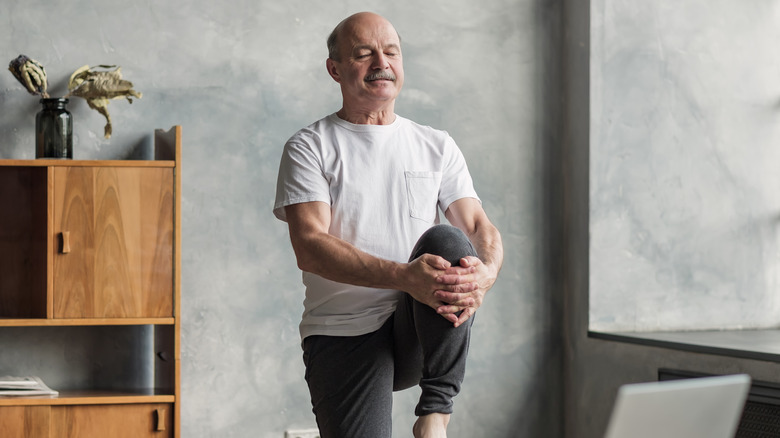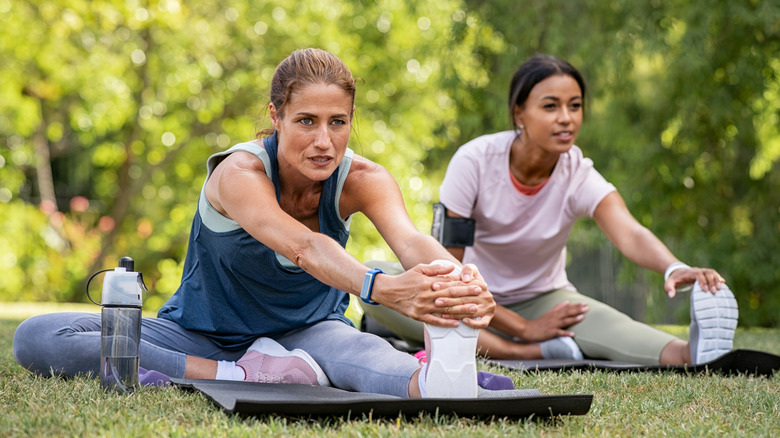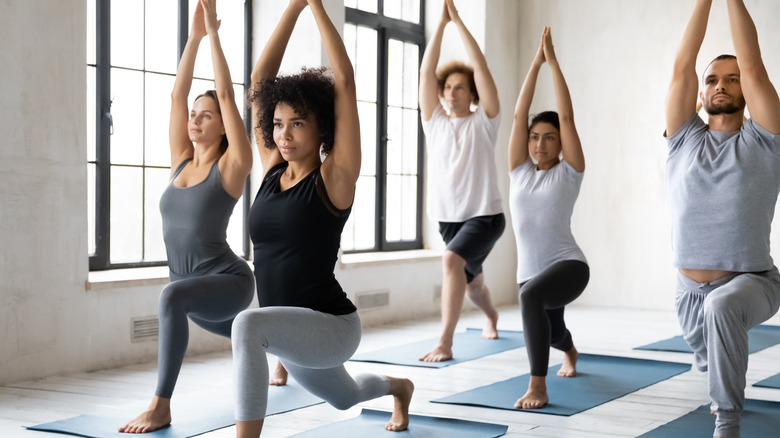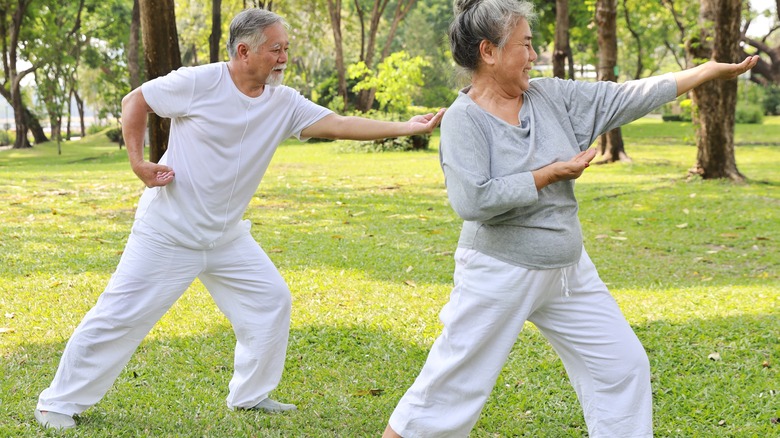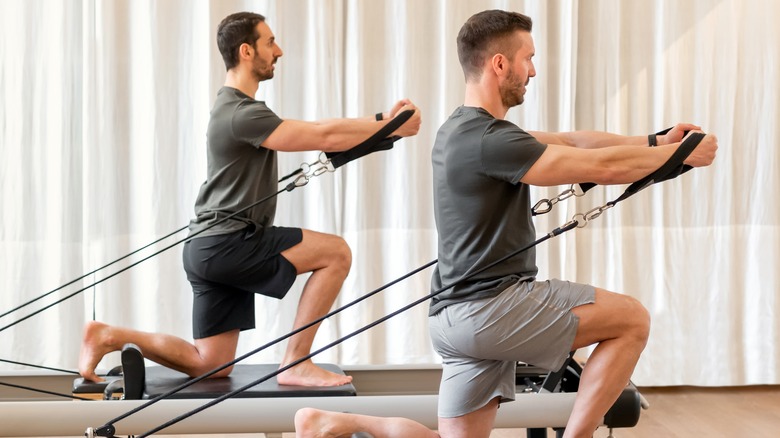The Best Exercises For People With Chronic Pain
Exercise may not be high on your list of things to do when you have chronic pain. But it turns out exercise has the potential to help ease feelings of chronic pain, according to a systematic review and meta-analysis from Neuroscience and Behavioral Reviews. A review from the Cochrane Database of Systematic Reviews defines chronic pain as any type of pain lasting more than 12 weeks (considered the amount of time it normally takes body tissues to heal).
Of course, not all forms of exercise are beneficial for those with chronic pain, and it's important to consider the type and severity of chronic pain you have as well as your preferences. In an article from the New York Times, Kirsten Ambrose, associate director of the Osteoarthritis Action Alliance at the University of North Carolina, says, "Certain activities may be friendlier to people with certain limitations." For instance, she goes on to explain that those with joint pain may find "non-weight bearing activities" such as swimming or bicycling more tolerable than activities that require the use of heavy weights or high impact movements.
With this in mind, you may have to do a bit of experimentation to find the best exercise routine to help you improve your current pain levels. Read on to learn how exercise can help chronic pain and which types of exercise have been shown to be beneficial for different forms of chronic pain.
Health professionals used to recommend inactivity for chronic pain — but that's changing
According to a review from the Cochrane Database of Systematic Reviews, health professionals used to recommend rest and inactivity for chronic pain. This might seem intuitive: If you're in pain, physical activity might exacerbate the pain, whereas resting can help you heal. But the review authors explain that this attitude is quickly changing. More healthcare systems are promoting exercise as a treatment for chronic pain.
This attitude shift is important, because your beliefs about the effects of exercise on pain can influence your outcomes. In a unique randomized controlled trial from Medicine & Science in Sports & Exercise, 83 participants were split into three groups: One group received positive messages about the effect of exercise on pain, one group received negative messages, and one group received neutral messages. The researchers found that participants' expectations about their pain influenced their actual feelings of pain after exercising.
So, your expectations of the effects of exercise matter here. Daniel Belavy, professor of physiotherapy, explains in an article from the New York Times that the kind of exercise that works best for you is the kind you enjoy and want to keep doing. He suggests there are many important considerations beyond your current physical limitations that will influence how well the exercise works for you, such as your fondness for your exercise instructor, the kind of clothes and shoes you wear, and even the kind of music you listen to.
Exercise may increase pain tolerance
One of the ways in which exercise may relieve chronic pain is by increasing an individual's tolerance to pain. A study from Medicine & Science in Sports & Exercise split participants into two groups: One group was instructed to do moderate to vigorous cardiovascular exercise three times per week, and the other group made no change to their current activity levels. The researchers found the group performing moderate to vigorous cardiovascular exercise increased their pain thresholds more so than the control group. While the participants in this study were healthy, the same principle applies to those who deal with chronic pain. A systematic review and meta-analysis from Neuroscience and Behavioral Reviews looked at 15 studies that tested the effects of various exercise programs on chronic pain, and the review authors found exercise could lower pain sensitivity in those who deal with chronic pain.
The inverse is also true: Inactivity can make individuals more sensitive to pain. In an article from the New York Times, Daniel Belavy, professor of physiotherapy at the University of Applied Sciences in Bochum, Germany, says that inactivity may actually make chronic pain worse in the long run by reinforcing pain sensitivity pathways. Taken together, these observations demonstrate one of the potential avenues through which exercise can alleviate pain. By increasing your tolerance to pain, regular exercise may cause you to feel less pain than you otherwise would have if you were inactive.
Walking can help with chronic pain
One of the most beneficial forms of exercise for those who deal with chronic pain is walking. A systematic review and meta-analysis from the Archives of Physical Medicine and Rehabilitation looked at 26 randomized controlled trials that tested the effects of walking on those with fibromyalgia, osteoarthritis, or chronic low back pain. The authors suggest walking can significantly improve outcomes in those who have these conditions. Similarly, another systematic review and meta-analysis from Disability and Rehabilitation that looked at randomized controlled trials of walking programs for those with chronic low back pain found walking could improve pain, disability, fear avoidance, and overall quality of life among those with low back pain.
Of course, walking can be done in many different ways. Healthline says walking for half an hour at least three to five times per week is enough to have beneficial effects on your strength and cardiovascular endurance, but depending on your current fitness levels, it may take time to build up to this level. For instance, if half an hour is challenging, start with just five or ten minutes, and slowly work your way up to longer walks. And if half an hour is easy, then start with 45 minutes or longer. The important thing is to increase the length of your walks over time. Of course, where you walk matters too: Choose a nice park or walking trail if there's one in your area that you enjoy.
Swimming can relieve chronic pain
Water therapy, i.e. exercises performed in a pool (including swimming), is another cardiovascular activity that's both extremely beneficial and low-impact, making it appropriate for many types of chronic pain. A review from the Journal of Pain Research explains that water therapy is known to improve the experience of pain as well as fatigue and quality of life in those with fibromyalgia. Another review from the Cochrane Database of Systematic Reviews suggests water therapy can help improve pain, disability, and quality of life among those with knee and hip osteoarthritis. And yet another review from the Journal of Huntington's Disease says water therapy can improve outcomes in those with Parkinson's disease or multiple sclerosis.
As Healthline explains, swimming is a great alternative to walking for people with mobility issues that may restrict their walking ability. Because the exercise is low-impact, its movements don't add stress on your joints and muscles, and it's likely to be beneficial for many different types of chronic pain. Of course, swimming and other water therapy exercises require access to a pool, which depends on where you live as well as your schedule and finances, but you may be able to find a public pool in your area that's free to use. If you like the idea of water therapy, it's worth searching online to see what sort of pools are available in your area.
Motor control exercises can reduce chronic pain
As a review from the Cochrane Database of Systematic Reviews explains, motor control exercises are a form of functional exercise meant to "restore coordinated and efficient use of the muscles that control and support the spine." A physical therapist guides patients to perform basic movements involved in simple tasks, and the exercises become more complex and target the deep trunk muscles as the patient's ability level improves. This review found motor control exercises to have similar benefits to those with chronic back pain as other forms of physical therapy. Similarly, a randomized controlled trial from the Journal of Exercise Rehabilitation found an intervention of motor control therapy combined with patient education caused significant improvements in both pain and disability among those with chronic low back pain.
While motor control exercise videos and instructions can be found online, it's best to start a new exercise regimen under the supervision of a professional, especially if you're dealing with chronic pain. As such, your ability to try this type of exercise will depend on the availability of physical therapists in your area as well as your finances, but keep in mind some physical therapists can do remote appointments. If this type of intervention interests you, it's worth looking online to see if you can find physical therapists in your area or online who are trained in this type of exercise.
Balance training can be beneficial for chronic pain
Another form of physical therapy shown to be effective for those with chronic low back pain is balance training. A randomized controlled trial from the Journal of Orthopaedic and Sports Physical Therapy split 79 participants with chronic low back pain into two groups: The experimental group did trunk balance exercises, while the control group did strengthening exercises. Both groups also did standard trunk flexibility exercises. The primary outcomes the researchers measured were self-reported pain intensity, disability, and quality of life. The researchers found that participants who performed trunk balance exercises had better outcomes than those who did strengthening exercises.
Another randomized controlled trial from Osteoporosis International split 53 postmenopausal, osteoporotic women who had experienced at least one spinal fracture in the past three years into two groups: One group received balance and strength training, and the other group received no training. The researchers found balance and strength training could improve balance, quality of life, and the experience of pain for those with osteoporosis.
As with motor control exercises, balance training is best done under the supervision of a physical therapist or health professional. If this type of training interests you, consider looking online to see what sort of physical therapists are available in your area, or talk to your healthcare provider about physical therapy options.
Strength and resistance training can be effective against chronic pain
Though they need to be done with caution, strength and resistance training can also be beneficial for those with chronic pain. A randomized controlled trial from BioMed Research International split 30 women with chronic neck and shoulder pain into two groups: One group performed 2-minute high intensity elastic resistance training every day for two weeks, while the other group just received a weekly email with general health tips. The researchers used electromyography to track activity in the skeletal muscles in both groups. After 10 weeks, the researchers found the resistance training group had reduced pain as well as longer and more frequent periods of total muscle relaxation as compared to the control group. The resistance training group also had increased muscle strength. The researchers note that while resistance training has the effect of tensing the muscles in the short term, frequently performing this training in the long term allows muscles to relax more completely in between sessions.
As Dr. Naveed Saleh explains in an article from MDLinx, strength and resistance training improve the muscles around joints and help to support bones and cartilage. Strength training also reduces stiffness, a common component of chronic pain. However, care should be taken not to overdo it when using free weights or practicing other types of weight training, as these are high impact exercises that have the potential to cause injury if performed incorrectly or at too high an intensity.
Stretching can help you deal with chronic pain
One of the most effective ways to ease chronic pain is to stretch. According to an article from FP Essentials, stretching is considered an effective non-pharmacological therapy for treating chronic pain. Additionally, a systematic review and meta-analysis that reviewed 33 studies with a total of 9,588 patients found trunk, pelvic, or leg stretching effectively decreased the amount of pain felt by patients.
It's important for stretching to target the part of the body that's in pain in order for it to be most effective. For instance, a systematic review from the Journal of Musculoskeletal and Neuronal Interactions suggests the McKenzie method — a series of lower back stretches tailored to a patient's mobility that increase in intensity over time — is a successful way to treat lower back pain and enhance physical function.
Healthline recommends stretching for lower back and neck pain, detailing specific stretches targeted to the lower back and neck. These stretches include the low back and glute stretch, as well as the levator scapula and neck stretch. But stretching any part of the body that's in pain is likely to have some benefit, as long as you ease into the stretch and be careful not to overdo it.
Yoga can make chronic pain go away
Specific forms of dynamic stretching, such as yoga, can be very beneficial for chronic pain. An article from Physical Medicine and Rehabilitation Clinics of North America explains yoga has been shown to improve pain in those with knee osteoarthritis, rheumatoid arthritis, neck pain, and lower back pain. It also decreases fear avoidance, increases self-efficacy, reduces stress, and improves sleep — all of which have a positive impact on the experience of chronic pain. Another study from Cerebral Cortex that compared practiced yogis to control subjects in North America found yogis had increased pain tolerance, suggesting yoga may help reduce the experience of pain by reducing sensitivity to pain.
Yoga may even help treat frequent headaches. A systematic review and meta-analysis from the Journal of General Internal Medicine found yoga could improve headache frequency, headache duration, and the intensity of headache pain in those who experience frequent tension headaches.
As there are many different types of yoga, the type that's best for each individual will depend on their specific conditions, needs, and preferences. Some yoga poses or routines may be too difficult for those with certain mobility issues, so a bit of experimentation may be necessary to determine the best yoga practice for you. For instance, the study from Physical Medicine and Rehabilitation Clinics of North America explains that Kundalini yoga involves only poses lying down, so it's likely a safe option for those who are new to yoga and/or have mobility issues.
Tai chi can help reduce chronic pain
Tai chi has been shown to help reduce chronic pain for those with fibromyalgia. A randomized controlled trial compared the effects of tai chi vs. cardiovascular exercise in those with fibromyalgia, and found tai chi to be more effective for pain reduction. The longer participants practiced, the more their pain level went down over time. This is an important finding, as cardiovascular exercise is one of the most commonly prescribed non-pharmacological treatments for fibromyalgia.
Tai chi may also help with chronic knee pain. Wei Liu, professor of physical therapy at the University of Texas Health Science Center at San Antonio, explains how his tai chi program can be beneficial for those with knee pain in an article from the New York Times. He analyzed people's movements while performing tai chi using motion capture sensors, and found that certain movements can be very beneficial to those dealing with chronic pain — just not all of them. His findings, published in a pilot study in the journal Gait Posture, show that certain movements of tai chi can be beneficial to those with knee osteoarthritis.
Pilates can help with chronic pain
Pilates has been shown to reduce chronic lower back pain (via an article from Physical Medicine and Rehabilitation Clinics of North America). Pioneered in the early 20th century by physical trainer Joseph Pilates, the movements focus mainly on enhancing muscle tone in the core. This in turn can improve postural balance, as explained by a randomized controlled trial from the Journal of Physical Therapy Science. This study compared the effects of Pilates to static stretching in 32 adults over a 12-week period, and found the Pilates group had more significant benefits than the static stretching group. Those who had practiced Pilates had improved postural balance, as well as other health metrics. As the article from Physical Medicine and Rehabilitation Clinics of North America explains, Pilates may reduce lower back pain in part by strengthening and toning the core muscles, conditioning you to have better posture.
Another trial from the Journal of Bodywork and Movement Therapies compared Pilates to abdominal curl-ups (one of the most commonly practiced exercises to improve tone in the abdominal muscles). Both groups were also compared to a third control group that didn't do either exercise regimen, and all three groups took two tests at the end of the study to measure their core and trunk strength and stability. Significantly more of the participants in the Pilates group were able to pass the tests than participants from either of the other two groups.
Individualized exercise-based treatment plans are most likely to be successful
Exercise can be very beneficial to those who deal with chronic pain. In fact, it may provide even more benefits than other interventions for chronic pain. A systematic review and meta-analysis from Neuroscience & Behavioral Reviews compared the effects of exercise to other interventions typically used to treat chronic pain. The researchers found exercise and movement can actually reduce pain even more effectively than many common alternatives such as massage, stress management, and pain education. This isn't to suggest that these interventions aren't effective in their own right, but physical activity may be one of the most effective ways to reduce pain and increase pain tolerance for those dealing with chronic pain.
That said, a lot depends on the specific exercise you choose. While any exercise is likely to be beneficial, exercise that targets and strengthens the area in need of treatment is most likely to help reduce chronic pain. As a textbook from Springer explains, the most effective exercise-based treatment plans are tailored to the individual, depending on the individual's specific type of pain, needs, and preferences. It's always recommended that you speak with a doctor or healthcare professional before embarking on a new training program, particularly if you have chronic pain, so you can get individualized advice about how (or if) this program is safe and potentially beneficial for your condition.
How to tell when it's time to rest
While exercise can be very beneficial for those with chronic pain (via a textbook from Springer), it's always important not to overdo it, especially when starting a new training program. Sports medicine physician Dominic King, DO explains in an article from the Cleveland Clinic that some amount of soreness is to be expected after a vigorous workout, but exercise should be avoided while you are actively in pain.
The American College of Sports Medicine (ACSM) defines DOMS (delayed onset muscle soreness) as soreness that begins 12-24 hours after a vigorous workout and may last up to two or three days. With DOMS, it's a good idea to keep activity light while recovering. This is different from acute soreness that can develop during a workout, which is a sign that you might be pushing too hard or using incorrect form. If you feel acute pain during a workout, the ACSM says you should stop the activity immediately.
Kirsten Ambrose, associate director of the Osteoarthritis Action Alliance at the University of North Carolina, suggests following the two-hour rule in an article from the New York Times. She says if pain is worse two hours after you finish exercising than before you began, this likely indicates you pushed too hard and should go easier next time. So, listen to your body when starting a new program, and make sure to set reasonable goals.







